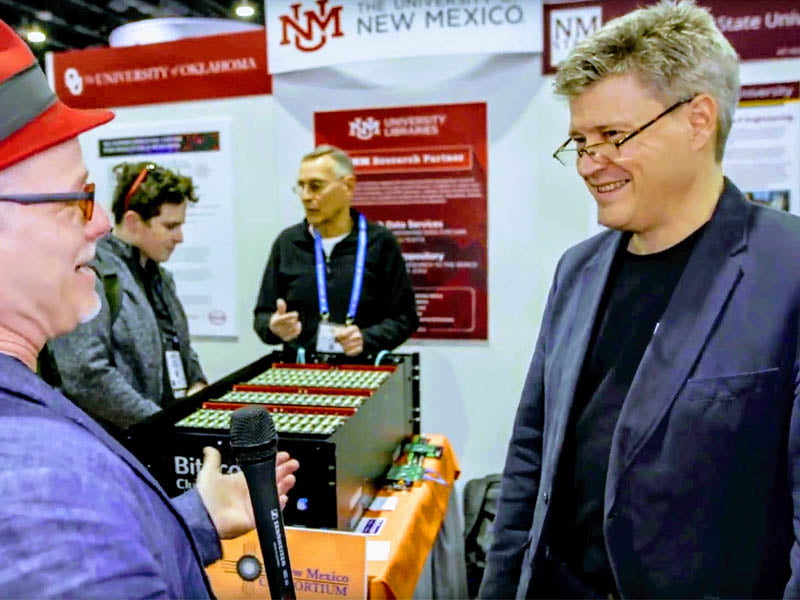Australia needs to get its act together fast with its incubator and accelerator programs, produce and or import more electronic engineering geeks quickly, and fix its poor research commercialisation problem.
So says Bruce Tulloch, managing director of Sydney-based BitScope Designs, which lays claim to helping out the US Los Alamos National Laboratory with clusters made up of super-cheap Raspberry Pi computers as part of its engineering chops.
Mr Tulloch says that Australia especially needs deep digital engineering talent right now.

He says the quality of Australian engineers coming out of our universities has declined in the last two decades, but is fortunately on the uptick – but only just.
“It’s beginning to turn around now as the Australian university sector seeks to re-invent itself,” says Mr Tulloch, who is also a member of JetPack Aviation, a company developing a ‘personal flight system’.
He is also on the board of The Studio, a startup co-working space involved with bootstrapping businesses in the media, entertainment and gaming and creative industries that is about to move into the $35 million Sydney Startup Hub.
He says government policy needs to sharpen up around developing the hard digital engineering skills required to develop the electronic in infrastructure that underpins everything from high performance computing, to IoT, to games consoles.
Mr Tulloch agrees with the proposition that while Australia’s research can be world class, we suck somewhat at commercialising it.
Part of the commercialisation problem is that our governments and enterprises won’t take a punt on locally developed tech, and that local investors don’t want to get involved with local startups until they have cracked offshore markets.
“It’s still prevalent today that it has to be proven overseas before we really invest,” he says.
BitScope was founded in 1999 and first made its name in selling PC-based oscilloscopes and logic analysers to engineers.
When the cheap and cheerful ARM-based Raspberry Pi teaching computer came on the market in 2012, Mr Tulloch saw potential.
“As we built up with Raspberry Pi, we got increasing numbers of requests for the equipment not just to measure things, but also the computers to process the results and make useful information out of it do useful things beyond the initial purpose of the device.
BitScope concocted a Raspberry Pi blade server module, which became the foundation of a high performance compute testing system, using clusters of the BitScope blades.
The clusters help prove out whether the software architecture of the HPC platform being constructed works, and form a considerable insurance policy given the actual HPC systems cost in the hundreds of millions of dollars.
BitScope’s most high profile Raspberry Pi cluster project so far is for the Los Alamos National Laboratory, which models and monitors the safety of the US nuclear weapons arsenal.
“It’s not like you can keep a petascale machine around for R&D work in scalable systems software,” said Gary Grider, leader of the High Performance Computing Division at Los Alamos National Laboratory, in an in-house article written by the lab.
“The Raspberry Pi modules let developers figure out how to write this software and get it to work reliably without having a dedicated testbed of the same size, which would cost a quarter billion dollars and use 25 megawatts of electricity.”
The Trinity machine at Los Alamos is roughly equivalent to running 100 million PCs at a time.
“A Raspberry Pi cluster is nothing like that obviously, but the projects all the big labs face in their exascale compute projects are similar,” says Mr Tulloch.
Mr Tulloch says the Los Alamos project is just the beginning of BitScope’s Raspberry Pi-powered clusters being used for HPC development work.
“Los Alamos is the lead on this, but the other US Department of Energy labs all build massive super computers for a variety of purposes.
“As the world shifts to artificial intelligence, big data and analytics more and more computational capacity is required and that requires scale and the problems of scale are the ones they haven’t got solutions to yet and that’s what this Raspberry Pi cluster is about it’s about giving them a testbed to evaluate research and develop at scale,” he said.
Mr Tulloch also sees a market for the lower power consumption ARM powered clusters in the currently Intel dominated server market, especially on the edges of IoT.
“Arm is the only architecture other than custom silicon that is likely to hit that market at scale,” he says.
Do you know more? Contact James Riley via Email.

